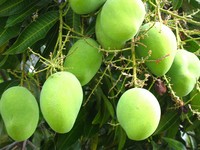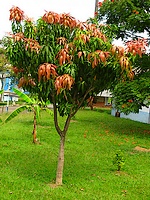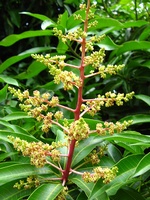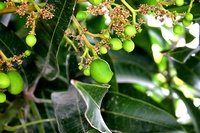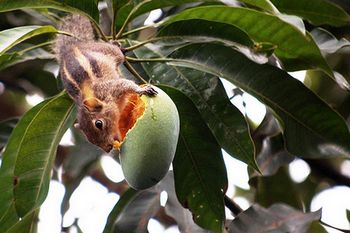I know more about growing mangoes than I'd like to. I live in a mango growing region... All my friends grow mango trees commercially!
Whether I like it or not, I do get suckered into helping out when extra hands are needed on deck...
Actually, it's not that bad. The reason so many people I know grow mangoes is thatmango trees are extremely easy to grow and manage.
In the right climate growing mangoes takes no effort or attention at all.
Through my friends I can get all the mangoes I want for free, and then some. But I still grow mango in my own garden, about a dozen different varieties.
Mangoes come in different colours and sizes, have different flavours, and they ripen at slightly different times.
Growing different mango tree varieties keeps things interesting, but most importantly it stretches out the harvest time of this feast or famine fruit. You can eat fresh mango for a few months instead of only a few weeks!
Where Can You Grow Mangoes?
Mangoes are a strictly tropical fruit. They love the tropics. The best climate to grow mangoes is frost free, with cool, dry winters and steamy, hot summers.
Mangoes like growing in light and free draining soils, they don't need rich soil. You actually get the best crops on soils of somewhat lower fertility.
Getting Started With Growing Mangoes
There are two ways to get started: you can buy mango trees at a nursery or you can grow your own from seed. The seed grown trees will take a lot longer to bear fruit. (Unless you know how to graft them or know someone who does.)
Mango trees that were grown in a nursery are usually grafted and should fruit within three to four years. Seedling trees may take five to eight years.
Seedling mango trees grow much bigger and stronger than the nursery trees and have an indestructible root system.
Grafted trees are of a more manageable size. Another advantage is that you know you will get a reliably bearing tree. If you grow mango from seed you need to know exactly which tree your mango seed came from or you won't know what you are getting until eight years later...
If you buy mango trees in a nursery I suggest you don't look just for size and colour. Have you ever tasted the variety you are about to buy? Some mangoes taste awful... True. Some of the commercial varieties are bred for shelf life, size and looks, but are barely edible. (Yes, I am totally spoiled when it comes to mangoes.) So, know the variety you buy!
Secondly, if you plan to grow more than one mango tree, find out if it is an early or late fruiting variety. Don't buy three trees that all fruit at the same time.
Thirdly, if you live in a cooler, subtropical area, make sure you get a variety that flowers well in those conditions. All mangoes will grow if your climate is frost free, but flowering habits depend on temperature and vary. And without flowers there will be little fruit...
And last but not least, especially if you live in an area where it may rain during the cooler time of the year, you should also look for a variety that shows good resistance to the mango disease anthracnose. (More on that below.)
If you buy your mango trees you can skip the next section:
Growing Mango Trees From Seed
Growing mangoes from seed is actually quite easy. (All the seeds of the mangoes I eat, dry and freeze are thrown out in the garden as mulch, and they all grow...)
The most important step is the seed selection! If you take any old shop bought seed it may not grow true to type. The seed needs to come from what is called a "polyembryonic" variety.
What that means is that the seed will sprout several identical trees. And those seedling trees will be identical to the parent tree. They are clones.
Ideally you know the parent tree, it's from your area, grows really well and gets a bumper crop every year! If not, oh well. Get seed from a polyembryonic variety and at least you know that the fruit you harvest will taste the same.
(The most common commercial variety in Australia, the Kensington Pride—also known as Bowen-—is polyembrionic. It's also a vigorous tree and usually fruits reliably, so it is well suited for seed growing.
If anyone knows a good variety to recommend to US readers, please let me know.)
The best time to grow mangoes from seed is the beginning of the wet season (beginning of summer).
Eat a nice mango, remove as much flesh from the seed as possible and then let it dry for a day or two.
To germinate the mango seed you could just put the whole thing in a warm, moist place and wait for it to sprout. Then cut off all the seedlings except for one. (The smallest supposedly gives you the best fruit.)
Or, if you prefer to fuss over them (or if you have only one seed but want half a dozen trees) then you can carefully cut a corner of the fibrous big seed. Cut only just deep enough so you can see the two halves of the seed, and then break it open.
Inside you find several small bean shaped seeds. Hopefully they are white and not all grey or brown and shrivelled...
You can plant those mango seeds individually. They should take about ten days to sprout. I like to sprout my seeds right where they are to grow. That way I don't need to worry about hardening them off (getting a shade grown seedling used to full sun) or about transplanting shock. If you are worried about the little thing getting eaten, uprooted or trampled you can always put a barrier around it.
If you prefer to first grow your mango tree in a pot, follow the instructions for nursery trees when it comes to planting time:
Planting A Mango Tree
You plant a mango tree just like you plant any other fruit tree, so I won't go into specifics here. (A page about planting fruit trees is coming soon.)
The best time to plant your mango tree is the beginning of the wet season (summer).
Make sure you select a place in full sun. (And make triple sure you really want a big tree there!)
The tree needs to be sun hardened. If your mango tree was grown in a shade house, gradually get it used to the sun first. Then dig a big enough hole. Carefully separate tree and pot without disturbing the roots. Put tree in hole, fill in, water.
Caring For A Mango Tree
I mentioned at the beginning that mangoes need little care. It's true.
Young mango trees do benefit from regular watering and a little fertilizing until they are established. But don't love your mango tree to death. Overwatering can kill it, especially if your soil is a bit heavy. And too much nitrogen fertilizer will make it weak and sappy, all leaves and little fruit, susceptible to bugs and diseases.
The older the tree gets, the less nitrogen it needs. Phosphorus and potassium are more important.
Mulch your mango tree heavily and spread a bit of compost every now and then. If your soil is reasonable that should be all the tree needs.
If the compost is made with wood ash, all the better. (Wood ash supplies potassium which will encourage fruiting and make the fruit taste better.) For mulch use only rough stuff like hay or lucerne, nothing that may mat down and become all soggy like grass clippings.
Fertilize mango trees in spring and summer only, and only a little at a time.
A good way of helping the tree is foliar spraying with fish fertilizer or seaweed solution. It provides trace elements and avoids deficiencies, but it doesn't overfeed.
But your best bet, even on very poor soil, is still lots of organic matter by way of compost and mulch.
When the tree is one metre high, cut it back by a third so it branches.
When those branches get to a metre, cut the tips off again.
That should give you a nice shaped tree.
Pruning A Mango Tree
Mangoes respond very well to pruning. And they are forgiving. Whatever you mess up, it will grow back...
Mangoes grow terminal flowers (they flower at the tip of a branch), so the more branches you have the better the crop. You can encourage lateral branching with tip pruning. (Only taking off the tips of branches.)
You should also aim for an open crown, taking out whole branches if the centre becomes too crowded, so that air and light can penetrate.
You can use pruning to keep your tree a manageable size and a nice shape. Mango tree growing too tall? Cut it down. Too wide? Cut it back.
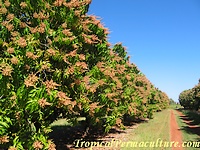
Pruning mangoes is not a science. In fact, the commercial growers here hire a big, scary machine with a long arm with three huge rotating blades.
The machine drives along the rows and gives the trees a good hair cut so they all end up exactly the same height and width... You can do something similar by hand if you want to keep your tree a certain size.
Usually mango pruning is done after harvest, though in some cooler areas the preferred time is just before flowering.
Ideally you prune only a little bit every year. If you let a mango tree grow much too big first, and then cut it back to a third of its size, the tree will likely skip the next crop... (Cut it back to a stump and it will take two years or more. But amazingly they will grow back even from that!)
Having said all that, after the initial cuts to encourage branching as mentioned in the previous section, you don't HAVE to prune a mango tree. If you don't mind having a real big tree, mangoes grow and fruit very well without pruning!
Flowering, Fruit Set And Harvesting Mangoes
Mangoes flower profusely and self pollinate very well.
The flowering is triggered by cool nights. In the true tropics a severe cold snap will bring out masses of flowers. For us a severe cold snap is a night below 15°C. In years where it doesn't get so cold we end up with poor crops.
(But there are mango varieties that flower well even when it doesn't get so cold... That's why I grow a dozen different ones.)
In colder climates it can easily be too cold for mango flowers to be viable. Selecting cold hardier varieties is important for you. (Nam Doc Mai would be a suitable variety in Australia.)
Initially you may see masses of tiny mangoes on your flower panicles, but the tree will shed a lot of them and keep only what it can handle. So don't worry if you see a lot of them drop off.
The mangoes will grow bigger and plumper, and eventually they will start to change colour. How long that takes depends on your climate. The hotter the weather the faster the mangoes ripen.
Usually your mangoes will be ready by the beginning of the wet season (late spring/early summer).
If your mangoes get eaten (wild birds, bats, possums, the neighbour's kids...) you can pick them half green. They will ripen at room temperature. (Ha! My rooms are about 40°C at that time of the year... when they say room temperature they mean 18-22°C.)
Be careful when harvesting mangoes, don't get any of the sap on you. The sap can spurt from the fruit stem when it snaps off and can cause burns, allergies and dermatitis.
It also burns the skin of the mango, which will go rotten at that spot.
(Doesn't matter if you eat it straight away, but it does when you pick them half green.)
The best way to harvest mangoes is to cut them off with a long section of stem still attached, and to handle them carfully so that the stem does not snap off.
Mango Pests And Diseases
The most serious mango disease is anthracnose, a fungus that can cause the flowers to go black and fall off. It also causes black spots on stem and small fruit, leaves may go brown...
Some varieties are more susceptible to it then others and it's worse in wet weather. It is worst in areas where it rains during flowering and fruit set. In areas with dry winters anthracnose can often be seen only once the fruit ripens. It develops black patches that go rotten...
Unless you want to spray nasty stuff, like copper solution or fungicides, you may have to live with anthracnose and accept some losses. A healthy tree with strong cell walls will show less infections than a weak one. So keep piling on that compost and spraying that seaweed...
There are many newer mango varieties that show good resistance to anthracnose. Get one of those if you live in a climate with winter rains!
Any other mango pests and diseases, like fruit spotting bugs and borers and whatever else is around, should be kept in check if you have a diverse permaculture garden that encourages beneficial insects.
One more hint is to forsake neatness and leave your lower mango tree branches drooping onto the ground. When everything else has been stung, sucked and eaten, there are usually still mangoes hiding under there...
Can You Grow Mangoes Indoors?
Nope. But you can grow mangoes in pots! So if it is just a little bit too cold in winter where you are, you can buy a dwarf variety and grow it in a tub and bring it inside during the coldest time of the year.
However, even a mango tree growing in a pot still needs lots and lots of heat and sun in summer. Growing mangoes indoors won't do!



